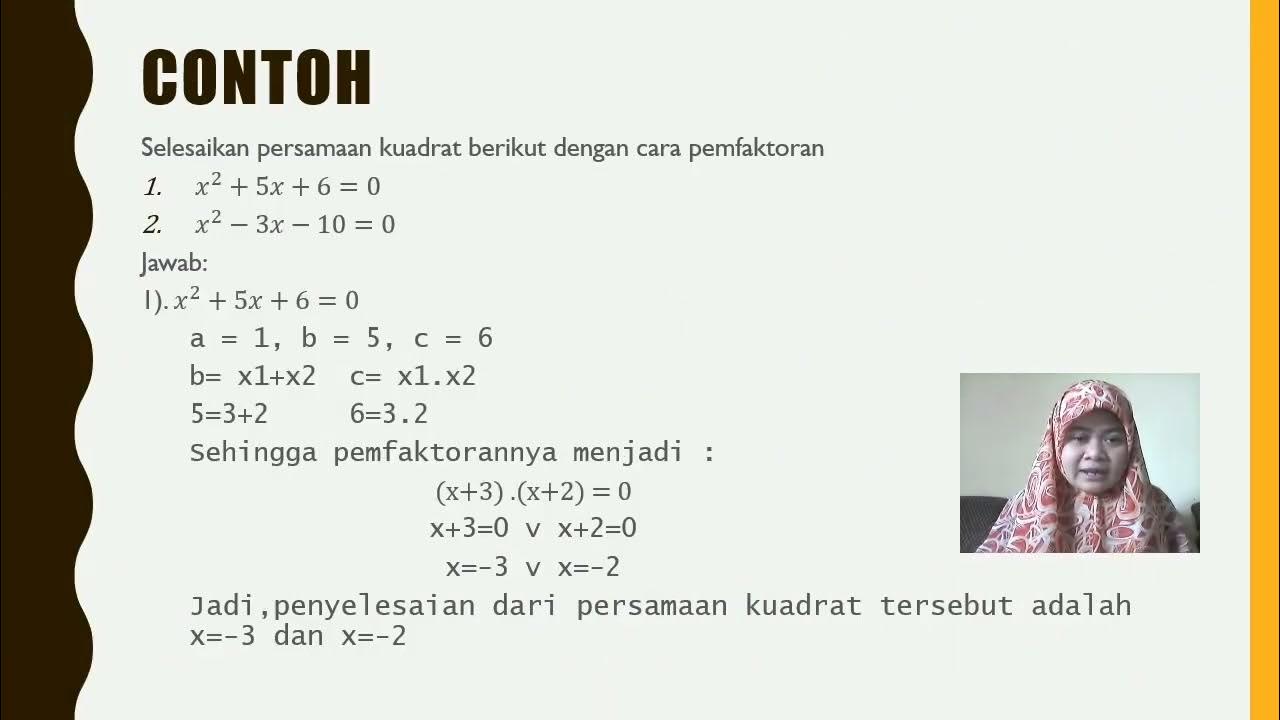Illustrating Linear Equations in Two Vairables | Writing Linear Equations in Standard Form
Summary
TLDRIn this educational video, the instructor discusses linear equations in two variables, focusing on their standard form, ax + by = c. The lesson defines linear equations and illustrates examples, emphasizing that the coefficients a and b must be non-zero real numbers. The video provides step-by-step guidance on converting equations into standard form and explains how to identify linear equations by checking their structure and exponent properties. Viewers are encouraged to subscribe for more math content, making this a valuable resource for learners looking to understand linear equations better.
Takeaways
- 😀 Linear equations in two variables can be expressed in the standard form: ax + by = c.
- 📐 For an equation to be a linear equation, a and b must be real numbers, and both cannot equal zero.
- ✏️ The variables in the equation are x and y, while a and b are their coefficients, and c is the constant.
- 🔍 An example of a linear equation in standard form is x + y = 0.
- 📝 Another example is 2x - y = 8, which also fits the standard form criteria.
- ⚖️ The equation 4y = 7 - 3x needs to be rewritten to identify its standard form.
- 🔄 To write linear equations in standard form, rearranging and isolating the constant on one side is essential.
- 🚫 Equations with negative exponents, variables in the denominator, or radical signs are not considered linear.
- 📊 The process of converting equations involves using additive inverses and simplifying the results.
- 👍 Engaging with these concepts through practice helps reinforce understanding of linear equations.
Q & A
What is the standard form of a linear equation in two variables?
-The standard form of a linear equation in two variables is expressed as ax + by = c, where a and b are coefficients and c is a constant.
What are the criteria for an equation to be considered a linear equation in two variables?
-For an equation to be a linear equation in two variables, the degree of both variables (x and y) must be one, and it should not have variables in denominators, negative exponents, or radical signs.
Can you provide an example of a linear equation in two variables?
-One example of a linear equation in two variables is x + y = 0.
How can you determine if an equation is in standard form?
-An equation is in standard form if it is structured as ax + by = c, with the x and y terms on one side and the constant on the other side.
What does it mean for coefficients a and b to be non-zero?
-For the equation ax + by = c to be a linear equation, both coefficients a and b must not equal zero; this ensures that both variables are present in the equation.
What is the process to convert an equation into standard form?
-To convert an equation into standard form, you need to isolate the constant on one side of the equation, often using additive inverses to simplify the expression.
In the example 4y = 7 - 3x, how would you rewrite it in standard form?
-You would add 3x to both sides, resulting in 3x + 4y = 7, which is the standard form.
What should you do if the first term of an equation is negative?
-If the first term of an equation is negative, you can multiply the entire equation by -1 to change the signs of all terms, making the first term positive.
What role do additive inverses play in solving linear equations?
-Additive inverses help simplify equations by allowing you to move terms from one side to the other, effectively cancelling out terms to isolate the variable.
Why is it important to have equations in standard form when studying linear equations?
-Having equations in standard form makes it easier to identify the coefficients and constants, facilitating graphing and solving the equations systematically.
Outlines

Esta sección está disponible solo para usuarios con suscripción. Por favor, mejora tu plan para acceder a esta parte.
Mejorar ahoraMindmap

Esta sección está disponible solo para usuarios con suscripción. Por favor, mejora tu plan para acceder a esta parte.
Mejorar ahoraKeywords

Esta sección está disponible solo para usuarios con suscripción. Por favor, mejora tu plan para acceder a esta parte.
Mejorar ahoraHighlights

Esta sección está disponible solo para usuarios con suscripción. Por favor, mejora tu plan para acceder a esta parte.
Mejorar ahoraTranscripts

Esta sección está disponible solo para usuarios con suscripción. Por favor, mejora tu plan para acceder a esta parte.
Mejorar ahoraVer Más Videos Relacionados

ILLUSTRATING LINEAR EQUATIONS IN TWO VARIABLES || GRADE 8 MATHEMATICS Q1

INTRODUCTION TO QUADRATIC EQUATIONS | GRADE 9

Teori Program Linear | Materi SNBT (UTBK) Penalaran Matematika

Persamaan Kuadrat part 1

Writing a Quadratic Function from Points (Example)

Persamaan Garis Lurus (1) | Menggambar Grafik PGL | Matematika Kelas 8
5.0 / 5 (0 votes)
